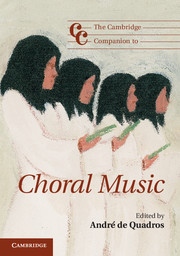Book contents
- Frontmatter
- 1 Introduction: choral music – a dynamic global genre
- Part I Choral music: history and context
- Part II Choral music the world over
- 6 Choral music and tradition in Europe and Israel
- 7 Canada's choral landscape
- 8 A multiplicity of voices: choral music in the United States
- 9 A hundred years of choral music in Latin America 1908–2008
- 10 Choral music in East Asia: China, Japan, and Korea
- 11 New voices in ancient lands: choral music in South and Southeast Asia
- 12 From chanting the Quran to singing oratorio: choral music in West and Central Asia
- 13 Voices of the Pacific: the (ch)oral traditions of Oceania
- 14 Choral music in Africa: history, content, and performance practice
- Part III Choral philosophy, practice, and pedagogy
- Notes
- Select bibliography
- Index
- Cambridge Companions to Music
7 - Canada's choral landscape
from Part II - Choral music the world over
Published online by Cambridge University Press: 28 September 2012
- Frontmatter
- 1 Introduction: choral music – a dynamic global genre
- Part I Choral music: history and context
- Part II Choral music the world over
- 6 Choral music and tradition in Europe and Israel
- 7 Canada's choral landscape
- 8 A multiplicity of voices: choral music in the United States
- 9 A hundred years of choral music in Latin America 1908–2008
- 10 Choral music in East Asia: China, Japan, and Korea
- 11 New voices in ancient lands: choral music in South and Southeast Asia
- 12 From chanting the Quran to singing oratorio: choral music in West and Central Asia
- 13 Voices of the Pacific: the (ch)oral traditions of Oceania
- 14 Choral music in Africa: history, content, and performance practice
- Part III Choral philosophy, practice, and pedagogy
- Notes
- Select bibliography
- Index
- Cambridge Companions to Music
Summary
Canada's choral culture is vibrant, diverse and widespread. Choral music is an integral part of every village, town, and city in this geographically large (just under 10 million square kilometers) but population-small (just over 33 million) country. Canada boasts world-class choirs and choral composers, whose works have gained international recognition.
What makes the Canadian choral scene unique and different from that of our southern neighbors, the United States? Is it our colonial past? Our bilingualism? Our geography? Our weather (a favorite Canadian topic of conversation)? Our collective desire to be distinct, in a polite and peaceful way? The impact of immigrant cultures and our concept of a diverse society? After all, the concept of Canada as a multicultural society is embodied in the Canadian Multiculturalism Act of 1985, which proclaims multiculturalism to be a “fundamental characteristic of the Canadian heritage and identity.” No doubt the answer lies in all of these influences and more.
While many Canadian choral works are solidly rooted in the folk, classical, and sacred music traditions of its founding peoples (primarily settlers from France and Britain), there is no doubt that immigrant communities, such as the Irish, the German-speaking Mennonites, Ukrainians and Eastern European Jews who came to our country in the nineteenth and early twentieth centuries, have also had an influence on composers and the way in which we approach choral music making.
- Type
- Chapter
- Information
- The Cambridge Companion to Choral Music , pp. 104 - 114Publisher: Cambridge University PressPrint publication year: 2012
- 1
- Cited by



